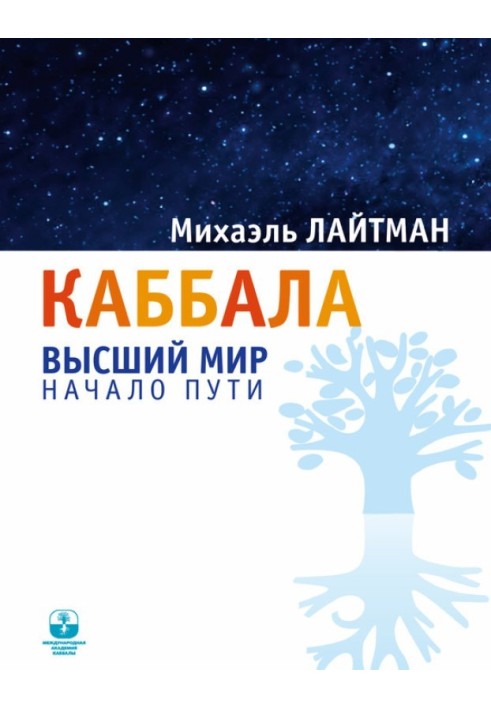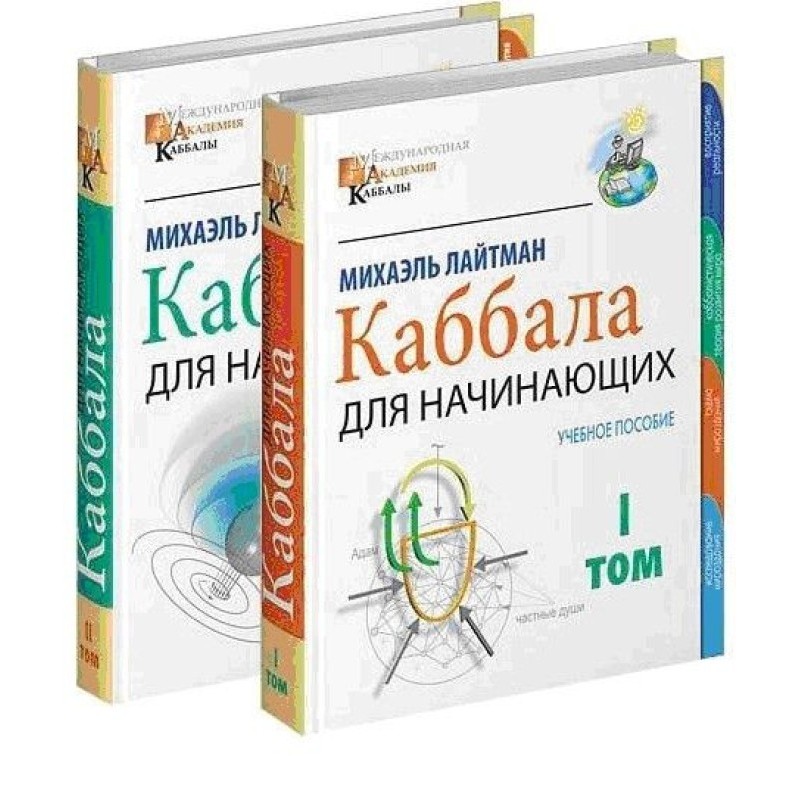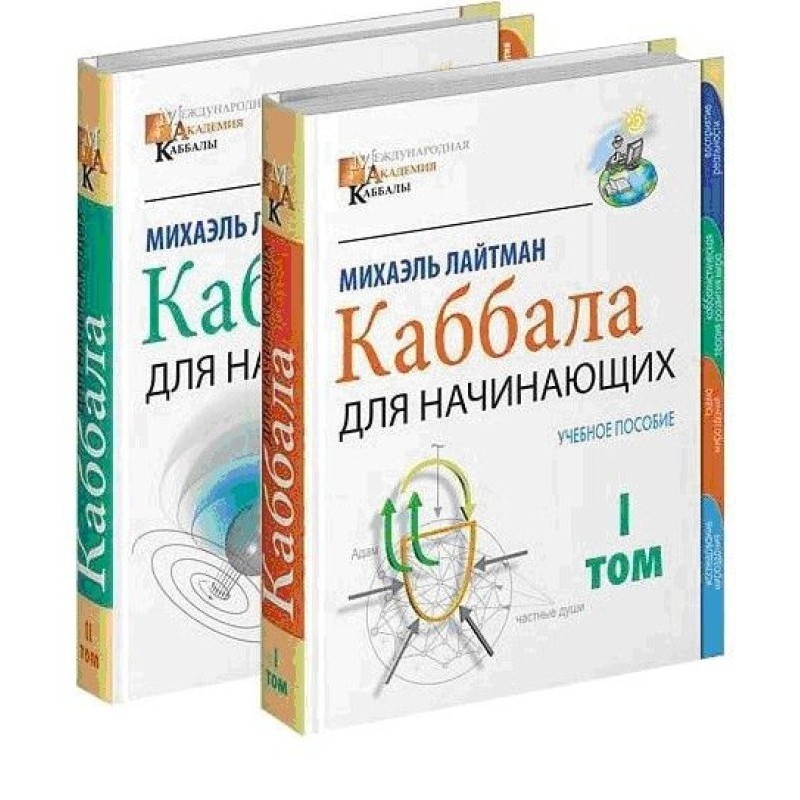Kabbalah. Upper world. The beginning of the way
 Instant download
Instant download
after payment (24/7)
 Wide range of formats
Wide range of formats
(for all gadgets)
 Full book
Full book
(including for Apple and Android)
Dear reader! Here is a textbook on Kabbalah, compiled under the guidance of the Kabbalah scholar, professor, head of the International Academy of Kabbalah Michael Laitman. This material was first published in 2007 and has been successfully republished many times under the title “Kabbalah for Beginners” in two volumes. Kabbalah gives us an idea of the structure of the system of forces that governs our world and the laws of its influence. Having mastered the presented material, you will receive initial information about the control system of our world and learn how to organically, integrally become involved in it as an active element capable of changing not only your existence, but also the future of all humanity. We sincerely wish you success in studying science and more great success in its rapid application in your of life! Contents: Part 1: Basics of KabbalahIntroductionPurpose of learningMain sections of KabbalahHistorical aspect of KabbalahKabbalah as a method of achieving similarity to natureThe essence of KabbalahThe subject of studying KabbalahWays to achieve the highest goalTwo systems: descent and ascentBasic elements of the universeOn what data is Kabbalah basedThe problem of reality in KabbalahAbstract namesLanguage of branchesPart 2: Educational processIntroductionInteraction between teacher and studentThe role of the teacher in KabbalahKabbalistic booksA brief description of the works of Baal HaSulamWhat is meant by study?The purpose of studying KabbalahThe learning processLessonThe effect of lightThe correct approach to studying Kabbalistic textsHomework Study opportunities1.1. Preface.1.2. Three components of reality.1.3. How we change the world.1.4. Kabbalah – the science of perception of reality.1.5. What is the world.1.6. Law of similarity of properties.1.7. Questions and answers. Test. Additional material. Commentary by Professor M. Laitman on the article by B. Ashlag (RABASH) “Preface to the book “Fruits of Wisdom. Letters" (the text of the article is in bold, the commentary is in normal font)2.1. Multiple approaches to the perception of reality.2.2. Kabbalistic method of perception of reality.2.3. Man defines his world.2.4. All worlds are inside a person.2.5. Imaginary world.2.6. Questions and answers. Conclusion. Test. Additional material. 3.1. Preface3.2. Darwin's theory and creationism (main principles) 3.3. Comparative analysis of two theories3.4. Conclusions4.1. Kabbalah and the secret meaning of the Pentateuch4.2. “The Pentateuch” – a description of the stages of comprehension of the Creator4.3. Creation intent and language Kabbalah4.4. The language of branches is a means for explaining the concepts of the Upper World. ConclusionTests for chapters 3 and 45.1. Atsmuto and the design of creation5.2. Creator and creation5.3. The starting point of creation5.4. Comprehension of reality5.5. Dividing partition5.6. Intermediate states5.7. The emergence of our world5.8. Intermediate phases and natural selectionConclusionTestAdditional material (Cambrian paradoxBin - the power of development)(Material taken from the article by R. Nudelman, magazine "Knowledge is Power", No. 8-9, 1998)[173]6.1. Law of cause-and-effect step development6.2. Purposefulness of stage-by-stage development6.3. The basis is an unchanging part of creation6.4. Searching in the dark or purposeful development6.5. Evolution continues6.6. Pressure from the forces of nature6.7. State of equilibrium 6.8. Development level "person" 6.9. The ultimate goal of human developmentConclusionTestFinal conclusions on the section “Kabbalistic model of the creation of the world”Additional material7.1. First Cause (Creator)7.2. Action of light7.3. Comprehension of reality7.4. Perception of the world7.5. Infinity Light, screen7.6. 125 levels of perception Test 8.1. Stages of direct light propagation8.2. Zero stage – Keter (Behina Shoresh) 8.3. The first stage is Hochma (Behina Aleph) 8.4. Basic states of creation 8.5. The second stage is Bina (Bhina Bet) 8.6. The third stage is zeir anpin (behina gimel) 8.7. The fourth stage is Malchut (Behina Dalet) 8.8. Development of desireTest 9.1. The World of Infinity (olam Ein Sof)9.2. Spiritual sense organs9.3. Stages of perception of reality9.4. World of Contraction (olam Tzimtzum)9.5. Malchut – creation9.6. How the filling of Malchut occurs Test 10.1. Construction of the Partzuf10.2. The order of the light entering the Kli10.3. World Adam Kadmon10.4. Features of the Partzuf SAGTest 11.1. Stages of creation and development of the Kli11.2. Ten Sefirot 11.3. Kabbalistic definitions11.4. World of Shrinking11.5. Screen and reflected light11.6. Rosh – toch – sof – partzuf (soul) 11.7. The emergence of worldsTest 12.1. Introduction12.2. The property of Bina and the property of Malchut 12.3. Connecting the properties of Bina with Malchut Test 13.1. The meaning of partitioning13.2. Second reduction (Tzimtzum Bet) 13.3. Confusion of Bina and Malchut Test 14.1. Principle of correction14.2. World of Atzilut, world of Correction14.3. System of worlds BEA14.4. Correction of Malchut Test 15.1. Adam is a special Partzuf15.2. Breakdown of blood vessels15.3. Corollary of the partition15.4. Correction procedure 15.5. Correction AHAP15.6. Division of Adam into souls15.7. The path of man 15.8. Correction - similar ConclusionTest 17.1. Introduction17.1.1. What Kabbalah studies17.1.2. What is free will?17.2. Cognition in modern science17.2.1. Knowledge of matter17.2.2. Cognition of form abstracted from matter17.2.3. Falsity of theoretical research17.3. Comprehension of matter in the science of Kabbalah 17.3.1. Matter is a force acting on the sense organs17.3.2. The basis of matter is the force contained in it17.3.3. In reality, only forces 17.3.4 exist. We do not comprehend forces - we comprehend their effect on us17.3.5. United power17.3.6. Method of research in Kabbalah17.3.7. Perception in Kabbalah17.3.8. Comprehension in Kabbalah17.3.9. Comprehensible and incomprehensible17.4. Questions and answersTestAdditional material18.1. Introduction18.2. Basic definitions18.3. Region research18.4. Questions and answersConclusionTestAdditional material19.1. Revealing the plan is to achieve Goal 19.2. Stages of comprehension19.3. Climbing stairs 19.4. Two aspects of force acting on a person19.5. The system of worlds is the system of human relations with the Creator19.6. Hiding and Revealing of the Creator 19.7. The disclosure of sensations depends on intention19.8. Existence in intention19.9. Is intention a feeling or a mind?10.19. Working with intention11/19. Qualitative and quantitative assessment in intention19.12. The spiritual world is the world of intention19.13. Difference between double and simple hiding19.14. Creating an intention19.15. Questions and answersConclusionTestAdditional material20.1. Four stages of desire development20.2. The structure of desire20.3. Achieving Goal 20.4. Correction of a person20.4.1. Two ways achieving Goal 20.4.2. Two types of control20.5. Lifting a person20.5.1. Interaction of stages 20.5.2. Degrees of sensation of the Creator (from top to bottom)20.5.3. Two types of analysis20.6. Questions and answersConclusionTestAdditional material1.1. Introduction1.2. The initial stage of the development of Kabbalah1.3. The origin of Kabbalistic methodology1.4. Period of Egyptian Exile: Pentateuch1.5. "Book of Zohar" 1.6. Lurianic Kabbalah1.7. Kabbalah of the Age of Enlightenment1.8. Modern approach to the presentation of Kabbalah1.9. ConclusionTestAdditional material2.1. Introduction2.2. The period from Adam to Abraham2.3. Tower of Babel, appearance of Abraham2.4. Period of Abraham2.5. Period of slaveryTest3.1 The era of the First Temple3.2 The era of the Second Temple3.3 From the collapse of the Second Temple to the present day3.4 The spiritual state of modern humanity3.5 Questions and answersTest4.1. Key questions4.2. Nature of the Creator4.3. Cause of destructiveness4.4. Intention4.5. Desire to please Test 5.1. Targeted development5.2. World of Infinity5.3. The meaning of stepwise development Test 6.1. Definitions in Kabbalah6.2. Development Goal 6.3. Internal workTest7.1. Approach to learning7.2. The essence of the commandment 7.3. Awareness of evil7.4. Perception of reality7.5. Degree of awareness of evil7.6. Gradual development of altruistic properties 7.7. Two forcesTest8.1. System of religious ethics8.2. Difference between ethics and Kabbalah8.3. The power that can change selfishness8.4. Reward principle8.5. Principle of similarity of properties8.6. Questions and answersTest9.1. Development of ideas about a Higher Power in the history of mankind9.2. The fundamental difference between Kabbalah and religion is in relation to the Creator9.3. The difference between a religious person from the Kabbalist.9.4. The relationship of Kabbalah to the purpose of creation9.5. Questions and answers. ConclusionTestAdditional material10.1. Man and Nature10.2. The question of the origin of the world and the essence of man in Western philosophy10.3. Crisis of traditional systems of thinking10.4. Why we need to compare Kabbalah and philosophy10.5. The influence of Kabbalah on philosophy and scienceTest 11.1. Kabbalah and philosophy as different ways of studying reality11.2. The problem of defining “spiritual”11.3. Difference between understanding and comprehension11.4. Question about the essence of the Supreme controlling force (Creator)Test 12.1. Study of matter and form12.2. Matter and form in Kabbalah12.3. The question of the essence and origin of matter12.4. Can the spiritual give rise to the material Test 13.1. The structure and origin of the universe from the point of view of Kabbalah13.2. About perception Reality TestConclusion 14.1. Picture of the world14.2. Criterion of the value of science14.3. The value of Kabbalah14.4. The reason for the small number of Kabbalist scholars14.5. Achievement is in effort14.6. Questions and answers Test 15.1. Kabbalah methodology 15.2. Biased picture of the world15.3. Kabbalah is the root of all sciences15.4. Questions and answersConclusionTestAdditional material16.1. Introduction16.2. Theory of faith16.3. Theory of dualism16.4. Denial theory16.5. Body and soul as scientific concepts in Kabbalah16.6. Open and hidden16.7. Prohibition on the use of abstract philosophy16.8. Criticism of the third theory16.9. Conclusions16.10. Questions and answers Test 17.1. Conditions for the development of the soul17.2. What does it mean to have a soul17.3. Three stages of soul development17.4. Purpose of soul circuits Test Additional material 18.1. Introduction18.2. Conditions for the development of creation18.3. Similarity of properties18.4. The driving force of human development18.5. The structure of Adam's common soul18.6. Partitioning Process18.7. Reason for splitting 18.8. Circulation of shape changesConclusionTestAdditional material
Data sheet
- Name of the Author
- Михаэль Лайтман
- Language
- Ukrainian
- Release date
- 2015
Reviews
Глибоке занурення у світ каббали
Книга "Каббала. Вищий світ. Початок шляху" стала для мене справжнім відкриттям. Автор, професор Міхаель Лайтман, майстерно пояснює складні концепції каббали, роблячи їх зрозумілими навіть для тих, хто раніше не мав справи з цією темою. Я особливо ціную, як він поєднує теоретичні аспекти з практичними порадами, що дозволяє читачеві не лише зрозуміти основи каббали, але й застосувати їх у своєму житті. Книга містить безліч корисних тестів та запитань, які допомагають закріпити матеріал. Вона надихає на глибше розуміння себе та світу навколо. Рекомендую всім, хто шукає духовного розвитку та прагне зрозуміти закони, що керують нашим життям!

























